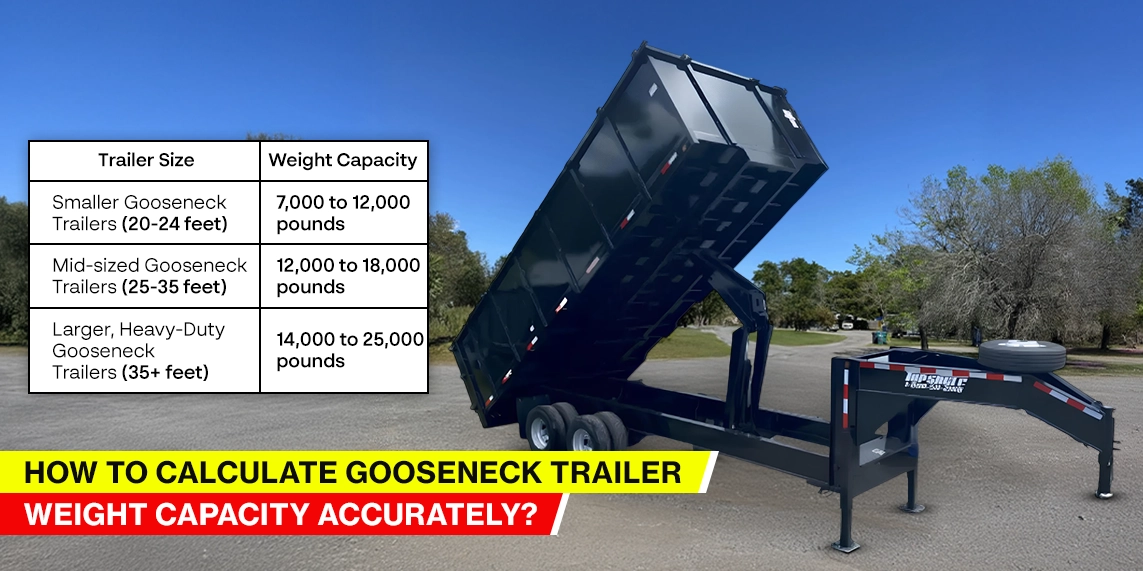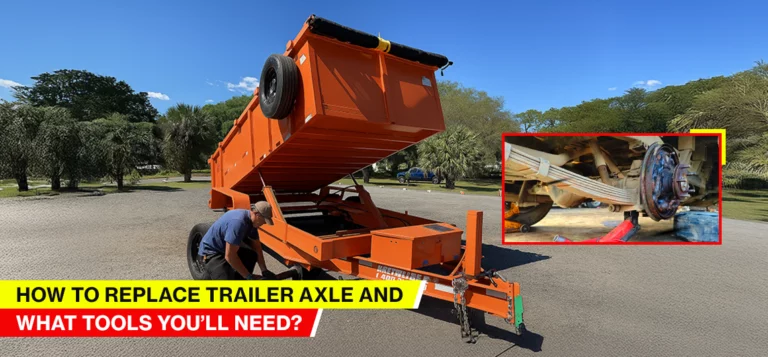Are you wondering about the gooseneck trailer’s weight capacity to transport your cargo? It is crucial to understand the trailer’s weight before purchasing it.
Gooseneck trailers are designed to transport heavy cargo seamlessly. Their detachable structure ensures easy transportation while moving heavy loads.
In this blog, we will learn about the gooseneck trailer weight capacity and how it helps make the right decision. It will also help you choose the model and necessary configuration according to your requirements.
Start Reading!
What Is Gooseneck Trailer Weight Capacity?
Gooseneck trailers are known for their gooseneck-shaped towing device. This gooseneck hitch connects the deck to the tow vehicle. This type of trailer effectively distributes the weight and enhances stability.
This trailer can be ideally removed for various loading and unloading needs. It ensures hassle-free loading and unloading of cargo with convenience. While transporting, the trailer and the front end are connected to start the transportation task.
The gooseneck trailer load limit depends on various factors, including the size of the trailer, the weight capacity of the towing vehicle, and the type of hitch attached to the trailer.
Exceeding the weight limit of a gooseneck trailer is considered dangerous and illegal. Overloading the trailer makes it unstable and challenging to control, leading to severe damage and accidents.
Thus, following the manufacturer’s guidelines or a professional before purchasing or using a gooseneck trailer is crucial.
| Factor | Description | Typical Example/Notes |
| Number of Axles | Total axles under the trailer. More axles = higher capacity. | Dual = 2 axles, Triple = 3 axles |
| Gross Axle Weight Rating (GAWR) | Maximum load each axle can support. | 7,000–9,000 lbs per axle |
| Total Axle Capacity | Sum of GAWRs from all axles. | 3 axles × 7,000 lbs = 21,000 lbs |
| Trailer (Tare) Weight | Weight of the empty trailer. Subtracted from total axle capacity. | e.g., 6,000 lbs |
| Maximum Payload Capacity | Total axle capacity minus trailer weight. | 21,000 lbs – 6,000 lbs = 15,000 lbs |
| Tire Load Rating | Maximum weight supported by each tire. Must match total trailer load. | Ensure all tires are equally rated |
| Frame Strength | Based on build material and design; affects structural integrity. | Steel frames support higher loads |
| Gooseneck Hitch Rating | Rating of the hitch system (must match or exceed trailer load). | Common rating: 25,000–30,000 lbs |
| Manufacturer’s Guidelines | Always refer to specs for legal limits and safety recommendations. | Found on trailer data plate or manual |
Factors That Affect Gooseneck Trailer Load Limits
Gross Axle Weight Rating (GAWR)
The load limit of a trailer is based on the size, towing vehicle capacity, and type of trailer hitch.
The gross vehicle weight rating of goosenecks ranges from 16000 to 30000 pounds. Crossing this range is illegal and can be hazardous, causing loss of control and accidents.
You must check with the professionals before loading your trailer to ensure safe operation. Before moving heavy loads with this trailer, it is essential to know the gooseneck trailer weight rating.
Different factors play a key role in determining the maximum weight of the gooseneck trailer. Each element is vital for stability, safety, and performance while transporting.
1. Number of Axles
The number of axles used to transport increases with the weight of the cargo. A single axle tows a light load along a smooth road. Multiple axles deal with a higher load limit as the weight is distributed over a larger area.
For instance, a triple-axle trailer supports significantly more weight than a dual-axle trailer. Each axle bears a portion of the load, reducing the strain on individual components. This helps increase stability during transport.
2. Axle Rating
The Gross Axle Weight Rating (GAWR) determines the axle rating. The vehicle’s axle supports this distributed weight.
The trailer can support additional weight if an axle features a greater diameter. For instance, an axle with a 4-inch diameter can carry approximately 9000 pounds.
Every axle on a trailer has a designated load rating, specifying the maximum weight it can safely bear. The total gooseneck trailer axle weight establishes the trailer’s overall load capacity.
It is crucial to ensure that the load’s overall weight does not surpass this total rating.
For example, if a trailer features three axles rated at 7,000 pounds, the total load limit would be 21,000 pounds. It is considered that all other factors, like frame strength and tire ratings, are taken into account.
3. Tire Ratings
Tires have load ratings indicating the maximum weight they can safely carry. The tire rating should align with the overall gooseneck trailer weight distribution of the load on the trailer. Underinflated or weak tires cause blowouts and other failures.
This may compromise safety during transportation. To ensure safe transportation, it is vital to choose tires appropriate for the trailer’s load requirements.
4. Frame and Suspension Design
It is crucial to consider the construction of the trailer’s frame and suspension system.
A strong and durable frame supports heavy loads without bending or falling, and a well-designed suspension system enhances the trailer’s functionality.
It ensures a smooth ride and prevents damage to the cargo and the trailer during transportation. A trailer with a robust frame and an efficient suspension system handles heavier loads much better.
Understanding these factors is essential for anyone looking to enhance the safe use of a gooseneck trailer. It ensures loads are transported efficiently without risk of equipment failure or accidents.
Typical Gooseneck Trailer Weight Capacity Ranges
The gross vehicle weight rating for a trailer depends on its size, towing vehicle capacity, and the type of trailer hitch. The gross vehicle weight rating of goosenecks can range from 16,000 to 30,000.
Hauling more than your trailer’s capacity can be hazardous and illegal, potentially causing instability, loss of control, and accidents.
Gooseneck trailers are flexible and popular for heavy loads owing to their distinct structure and stability. They are designed for towing by a pickup truck with a gooseneck hitch connected to the truck’s bed.
It enables them to manage heavier loads than standard bumper-pull trailers. Considering the maximum weight of a gooseneck trailer is vital for choosing one that fits your transportation requirements.
Let us understand how much a gooseneck trailer can haul –
1. Smaller Gooseneck Trailers (20-24 feet)
The smaller gooseneck trailers provide high-weight capacities. These trailers measure 20-24 feet and support a weight of 7,000 to 12,000 pounds.
The smaller trailers improve the seamless management of cargo transportation.
This makes them suitable for light to moderate hauling needs. These trailers are often used for transporting machinery, small vehicles, and equipment. They are perfect for landscapers and contractors who need a reliable option for carrying their tools and materials.
Due to their shorter structure, smaller gooseneck trailers are easy to maneuver, making them ideal for urban settings and other job sites.
2. Mid-sized Gooseneck Trailers (25-35 feet)
Mid-sized gooseneck trailers generally range between 25 and 35 feet in length. Their significant weight capacity and stability help them transport heavy loads.
Mid-sized or short trailers enhance maneuverability. They tend to be more active and are perfect for moving through confined areas or crowded places.
The longer trailers might need broader turning radii and be easier to handle in tight areas. However, they will be harder to maneuver in reverse, particularly with sharp corners or confined areas.
Mid-sized gooseneck trailers usually have a weight capacity of 12,000 to 18,000 pounds, which helps strike a balance between size and load capability.
These versatile trailers can be utilized for a range of applications, including transportation of construction materials, heavier equipment like skid steers, or even livestock.
The increased length provides better stability while towing. It functions well at higher speeds or on uneven surfaces, making it a favored choice for serious contractors and farmers.
3. Larger, Heavy-Duty Gooseneck Trailers (35+ feet)
Gooseneck trailers are popular for their considerable dimensions and weight limit. They generally measure between 20 and 40 feet in length and can transport 14,000 to 25,000 pounds.
This makes them perfect for transporting heavy loads and gear, providing more storage capacity. These trailers offer a more comfortable ride than conventional trailers.
In this growing industry, a 35-foot gooseneck trailer is appropriate and essential. According to industry standards, it has better load capacity and flexibility.
It is known for providing additional length and is vital for optimizing revenue and operational effectiveness.
These trailers are intended for transporting the heaviest loads, including construction machinery, industrial equipment, and buses or large trucks. The larger and heavy-duty trailers include adjustable axles, ramps for loading heavy machinery, and advanced braking systems.
One of the ideal features of a heavy-duty gooseneck trailer is that it ensures safety while transporting heavy loads.
They are well-equipped to handle high gooseneck trailer towing capacity, ensuring adequate transportation.
Knowing the load limits of gooseneck trailers is essential. This will help you choose the ideal one for your requirements. Whether you need a compact model for light transport or heavy loads, gooseneck trailers meet all your requirements.
How to Calculate Gooseneck Trailer Weight Capacity?
When using a trailer, a key piece of information you must understand is its maximum weight, also known as the maximum payload. You should avoid exceeding a trailer’s weight limit.
If neglected, it can harm the trailer, vehicle, or cargo and may also lead to accidents.
Choosing the right trailer for your requirements is beneficial. It enhances operational efficiency, reduces downtime, and increases profitability.
Knowing how to calculate gooseneck trailer weight capacity allows you to avoid overloading, which can lead to safety hazards and potential damage to the trailer and your towing vehicle.
Here’s a simple guide on how to calculate gooseneck trailer’s weight capacity –
1. Determine Trailer’s Empty Weight
The trailer’s weight is known as “curb weight” or “empty weight”. It refers to the trailer’s weight when no cargo or passengers are onboard.
It includes the weight of the trailer frame, wheels, and any permanent equipment or attachments. The first step in understanding your gooseneck trailer’s weight capacity is to find the empty weight. This includes the structural parts of the trailer, like the frame and axles, without load.
2. Find GVWR
The GVWR represents the trailer’s highest allowable weight and load. This rating refers to the trailer’s weight, which includes cargo, fluids, passengers, and extra accessories or gear.
Gross vehicle weight rating (GVWR) refers to the highest permissible weight for a specific vehicle. The GVWR indicates the maximum total weight of a trailer, as mentioned by the manufacturer. The Gross Vehicle Weight Rating certifies a trailer to safely transport any loaded cargo. It is an essential figure that trailer owners must know.
3. Subtract To Get Payload Capacity
Payload capacity refers to the highest-weight vehicle that can securely transport within the cabin and cargo space. This includes individuals, equipment, baggage, or any other cargo positioned on or within the vehicle.
It refers to the maximum weight the vehicle can support. Exceeding the payload limit can harm the vehicle and compromise safety during operation.
4. Consider Gooseneck Trailer Axle Weight and Limits
Axle weight and limits are generally on the tag or plate attached to the axle. You can determine the axle weight limit by measuring the diameter of the axle. You must consider that some gooseneck trailers feature multiple axles, and every axle has its weight capacity.
GVWR vs. Payload Capacity
GVWR and payload capacity are essential elements in vehicle design and functionality. They affect cargo safety and handling. GVWR (Gross Vehicle Weight Rating) represents the highest weight a trailer can safely transport.
Understanding these concepts helps maintain safe and effective transportation, avoid overloading, and optimize cargo capacity.
The payload capacity is the variance between the GVWR and the curb weight (the vehicle’s empty weight). It shows how much extra weight can be safely included.
Gooseneck trailer GVWR directly relates to payload capacity, as it is used to calculate a vehicle’s maximum payload capacity.
By subtracting the vehicles curb weight from the GVWR, you can determine the maximum weight that can be placed on the truck before its suspension limits are reached.
GVWR is directly connected to payload capacity. It is used to determine the vehicle’s maximum gooseneck trailer payload capacity.
Subtracting the vehicle’s curb weight from the GVWR will help you find the maximum weight that can be loaded into the truck before reaching the suspension limits.
GVWR is crucial to ensure it isn’t overloaded. It could lead to possible damage, safety risks on the road, and legal consequences.
Finding GVWR Information
Finding the gooseneck trailer GVWR details is relatively easy. They are usually located on a sticker or label on the driver’s side door sill.
You may also refer to the owner’s manual or the manufacturer’s website to find your truck’s GVWR. Knowing this is crucial for calculating payload capacity. You can ensure safe and efficient transportation of cargo.
Calculating Payload Capacity
Understanding your vehicle’s gooseneck trailer payload capacity is essential for determining payload capacity. It helps you carry out safe and efficient cargo transportation.
Haul With Confidence With Our Gooseneck Trailers!
Are you looking for a gooseneck trailer for your business or personal needs? Choose the finest quality available. Selecting a premium gooseneck trailer ensures it will adequately fulfill your requirements.
Understanding the GVWR and the trailer’s weight is crucial. It allows you to determine the maximum cargo your trailer can carry without exceeding its capacity.
You must follow the necessary regulations and consider other elements. Weight distribution, tongue weight, and gooseneck towing capacity ensure a secure towing experience.
Proper maintenance, upkeep, and compliance with legal standards will help you prevent potential risks and keep your trailer in excellent shape.
We at Top Shelf Trailers bring you the finest gooseneck dump trailers for transporting diverse loads.
We are one of the leading dump trailer producers in the US. Get top-notch trailer assistance and towing gear.
Choosing an ideal type of gooseneck dump trailer is advantageous. You can rely on this based on their strength and ability to tow heavy loads.
Reach out to us and discover the convenience of our top-grade trailers!




